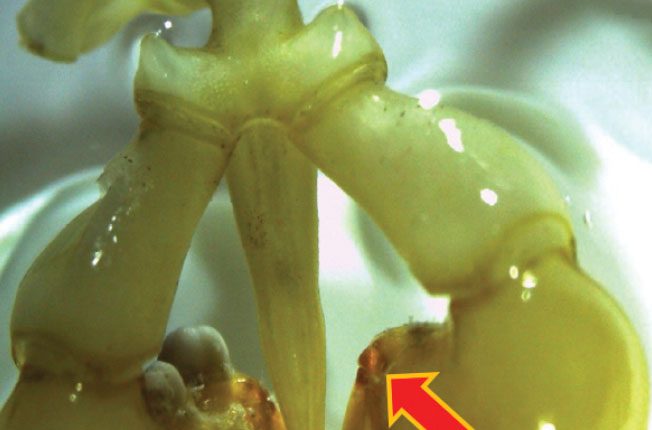A NEW spider-like creature has been hauled up from the bottom of the ocean near Antarctica.
The strange yellow “sea spider” has giant claws and uses its legs to breathe, scientists say.
It’s been named Austropallene halanychi, and was found nearly 1,900 feet below the surface of the Ross Sea.
The creature had never been seen before until it was pulled up in a net in January 2013.
It was the only specimen collected as part of a trawl by ice-breaking vessel RVIB Nathaniel B. Palmer.
Once collected, it was preserved in 95% ethanol and has now finally been classified as a brand new species.
It’s larger than a typical sea-spider with 1.2-inch legs (but is far from the biggest, with some species having legs pans over two feet) that it breathes through.
The creature has a tubular proboscis, which works as a kind of feeding straw – in place of a mouth.
It was described as having “four darkly pigmented eyes” by Jessica R. Zehnpfennig and Andrew R. Mahon in the study published in ZooKeys.
Its chelifores – which are like the small arms of sea spiders – have large claws, making the creature unique.
Most read in News Tech
“The new species can be differentiated from all other described Austropallene species based on its much larger size, as well as its unique and distinctive chelifores,” scienciests explained.
“The chelifore claw…closes completely when the fingers converge, with no visible space remaining between the fixed and movable fingers.”
These are typically used by sea spiders for hunting – no surprise given that the creature is distant related to crabs.
Its legs are doubly interesting because they’re also used for mating.
The specimen that was captured near Antarctica had large organs for carrying female eggs.
Researchers are now certain that the creature found 200 miles from the South Pole is new to science.
“Overall, the combination of morphological characteristics and molecular evidence leaves no doubt that this is a new Antarctic species of Austropallene.”
Sea spiders
Sea spiders are arthropods, which typically means they have an segmented exoskeleton with jointed limbs and a chitin sell that is shed.
More than 1,300 species of sea spiders have been found all around the world.
Their leg spans range from as short as 0.04 inches right up to 2.3ft in length.
The majority are small, but larger sea spiders have been found in deep waters and in the Antarctic.
It’s important to note that sea spiders aren’t true spiders or arachnids.
They usually have four pairs of walking legs, totalling eight – but some species have five and even six pairs.
The legs are typically much longer than the sea spider’s body, and absorbs gases to “breathe”.
Sea spiders have been found in many parts of the world, including the USA, Australia, New Zealand, the Mediterranean Sea and the Caribbean Sea – as well as the north and south poles.
Sea spiders can live at many depths, including as low as 23,000ft – but most are found in shallow waters.
Read more on The Sun
They are typically predators that feed on a range of sea creatures including sponges.
Sea spiders can also insert their proboscis into sea anemones to feed in a parasitic relationship.












